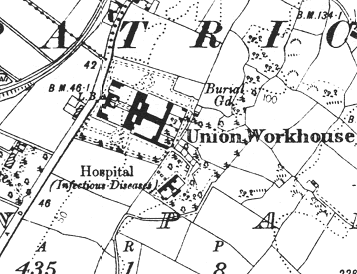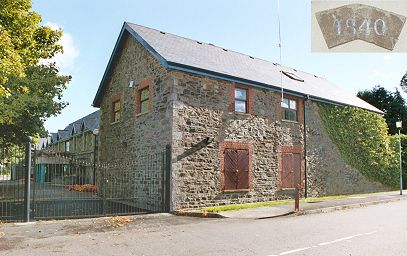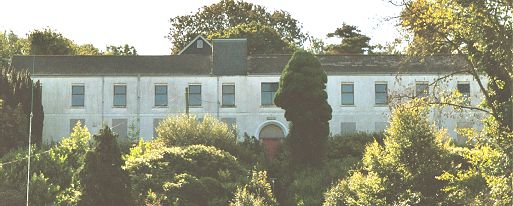Strabane, Co. Tyrone
Strabane Poor Law Union was formally declared on the 8th April 1839 and covered an area of 209 square miles. Its operation was overseen by an elected Board of Guardians, 25 in number, representing its 24 electoral divisions as listed below (figures in brackets indicate numbers of Guardians if more than one):
Co. Tyrone:
Altaclady, Ballymagorry, Ballyneaner, Barron's Court, Church Lands, Douglas Burn, Dunnalong, Dunnamanagh, Caums, Glenmornan, Mountcastle, Newtown Stewart, Strabane (2), East Urney.
Co. Donegal:
Castle Finn, Cloghard, North Clonleigh, South Clonleigh, Feddyglass, Figgart, Raphoe, St Johnstown, Treantaghmucklagh, West Urney.
The Board also included 5 ex-officio Guardians, making a total of 30. The Guardians met each week on Tuesday.
The population falling within the Union at the 1831 census had been 62,084 with divisions ranging in size from Ballyneaner (population 1,656) to Strabane itself (5,556).
The new Strabane Union workhouse was originally planned to be built at Magirr in the Bridge Street area of the town, on land owned by the Marquis of Abercorn. The site was eventually rejected as unsuitable and the workhouse was erected in 1840-1 on a five-acre site to the north of Strabane, on the east side of the Londonderry Road. Designed by the Poor Law Commissioners' architect George Wilkinson, the building was based on one of his standard plans to accommodate 800 inmates. Its construction was carried out by Messrs Patterson and Catcheside at a cost of £6,885 plus £1,355 for fittings etc. The workhouse was declared fit for the reception of paupers on 18th November 1841 and admitted its first inmates on the same day.
The workhouse location and layout are shown on the 1909 map below.

Strabane workhouse site, 1909.
The buildings followed Wilkinson's typical layout. An entrance and administrative block at the west contained a porter's room and waiting room at the centre with the Guardians' board room on the first floor above. Extensions were later added at each side to provide children's accommodation and school rooms.

Strabane entrance block from the south-west, 2003.
© Peter Higginbotham.
The main accommodation block had the Master's quarters at the centre, with male and female wings to each side. At the rear, a range of single-storey utility rooms such as bakehouse and washhouse connected through to the infirmary and idiots' wards via a central spine containing the chapel and dining-hall. A burial ground was located to the north-east.
During the Great Famine in 1845-9, a 70-bed fever hospital was erected at the south-east of the workhouse. A house was hired to accommodate an additional 36 inmates.

Strabane fever hospital from the north-west, 2003.
© Peter Higginbotham.
Food in the workhouse was prepared in two 400-gallon boilers, with a further 100-gallon boiler used to "stirabout". Each inmate received buttermilk, except for the infirm and young children who were given sweet milk. A typical week's provisions comprised:
1000 lbs. bread 60 lbs. meat 9 beef heads 2 cwts. salt 10 ozs. tea 12 lbs. sugar 10 cwts. Indian meal 10 cwts. oatmeal 1600 quarts buttermilk 500 quarts new milk 1 lb. pepper 9 barrels of turf
Discipline in the workhouse was strict. Some of the offences and their punishments recorded in the 1840s included:
- Refusing work — 12 stripes of a rod
- Stealing money — 14 stripes and 8 cold baths over 4 weeks
- Throwing stones and annoying a lunatic — 20 stripes, or 12 hours confinement, loss of a meal, and cold shower
- Running away from workhouse — No milk for 14 days
- Stealing food — No milk for 2 days
At the 1901 census, the population of the Union was 35,859 with 15 officers and 250 inmates in the workhouse.
In February 1922, the IRA tried to burn down the workhouse to prevent its use by British military personnel. However, the attempt failed as reported by the Tyrone Constitution:
NURSE'S TERRIFYING ORDEAL
Much excitement was created in Strabane and district when it was learned early on Thursday morning that an attempt had been made to burn the Strabane workhouse, either late on Wednesday night or on Thursday morning. |
In the 1930s, part of the dining hall block was used as a Mass House by Roman Catholics from the north side of Strabane. During the Second World War, the workhouse was used by the services as a NAAFI and for staff billets.
The entrance block later became part of Strabane District Council Offices. The fever hospital became a district hospital in 1922 and was later Strabane Hospital. The main building and infirmary were demolished in around 1964.
Records
Note: many repositories impose a closure period of up to 100 years for records identifying individuals. Before travelling a long distance, always check that the records you want to consult will be available.
- Public Record Office of Northern Ireland, 2 Titanic Boulevard, Titanic Quarter, Belfast BT3 9HQ. Holdings include Board of Guardians' minutes (1939-1948); Indoor registers (1862-1921); etc.
Bibliography
- The Workhouses of Ulster by Michael H Gould (1983, Ulster Architectural Heritage Society).
- Workhouses of the North West Edited by Jack Johnston (1996, WEA)
- The Workhouses of Ireland by John O'Connor (Anvil Books, 1995)
Links
- None.
Unless otherwise indicated, this page () is copyright Peter Higginbotham. Contents may not be reproduced without permission.


